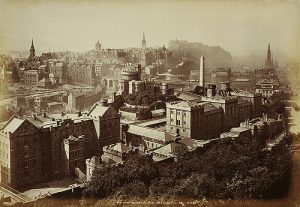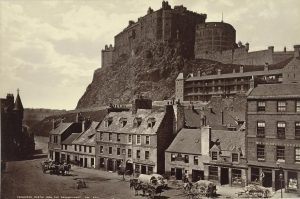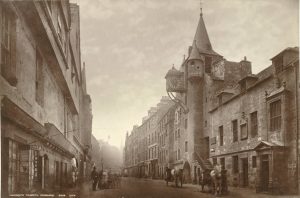RLS in Edinburgh | Homes & Haunts | Fictional Edinburgh | Gothic Edinburgh
Kidnapped
”It was coming near noon when I passed in by the West Kirk and the Grassmarket into the streets of the capital. The huge height of the buildings, running up to ten and fifteen stories, the narrow arched entries that continually vomited passengers, the wares of the merchants in their windows, the hubbub and endless stir, the foul smells and fine clothes, and a hundred other particulars too small to mention, struck me into a kind of stupor of surprise, so that I let the crowd carry me to and fro” (Kidnapped, The Works of Robert Louis Stevenson, Swanston edn, vol x [London: Chatto and Windus, 1911], p. 306). RLS also set part of Kidnapped at the Hawes Inn, 7 Newhalls Road, South Queensferry.

“The Misadventures of John Nicholson”
“The Calton Hill, about this period, had an ill name of nights; and to be sitting there with four hundred pounds that did not belong to him was hardly wise. He looked up. There was a man in a very bad hat, a little on one side of him, apparently looking at the scenery; from a little on the other a second night-walker was drawing very quietly near. Up jumped John. The envelope fell from his hands; he stooped to get it, and at the same moment both men ran in and closed with him’”(RLS, “The Misadventures of John Nicholson”, The Works of Robert Louis Stevenson, Swanston edn, vol x [London: Chatto and Windus, 1911], pp. 10-11).
“The Lamplighter”
My tea is nearly ready and the sun has left the sky;
It’s time to take the window to see Leerie going by;
For every night at tea-time and before you take your seat,
With lantern and with ladder he comes posting up the street.
Now Tom would be a driver and Maria go to sea,
And my papa’s a banker and as rich as he can be;
But I, when I am stronger, and can choose what I’m to do,
O Leerie, I’ll go round at night and light the lamps with you!
For we are very lucky, with a lamp before the door,
And Leerie stops to light it as he lights so many more;
And O! before you hurry by with ladder and with light,
O Leerie, see a little child and nod to him to-night!
(A Child’s Garden of Verses, The Works of Robert Louis Stevenson, Swanston edn, vol xiv [London: Chatto and Windus, 1911], pp. 20-21).

The Wrecker
“I went to Arthur’s Seat and the Calton Hill, heard the band play in Prince’s Street Gardens, inspected the regalia and the blood of Rizzio, and fell in love with the great castle on its cliff, the innumerable spires of churches, the stately buildings, the broad prospects, and those narrow and crowded lanes of the old town where my ancestors had live and died in the days before Columbus” (The Wrecker, The Works of Robert Louis Stevenson, Swanston edn, vol xiii [London: Chatto and Windus, 1911], p. 38).
Catriona
“Here I was in this old, black city, which was for all the world like a rabbit-warren, not only by the number of its indwellers, but the complication of its passages and holes. It was indeed a place where no stranger had a chance to find a friend, let be another stranger” (Catriona, The Works of Robert Louis Stevenson, Swanston edn, vol xi [London: Chatto and Windus, 1911] p. 8).
Weir of Hermiston
“if anybody had but noticed it, there was an ill-looking, vagabond crew, the scum of Edinburgh, that drew out of the market long ere it was dusk and took the hill-road by Hermiston, where it was not to be believed that they had lawful business” (Weir of Hermiston The Works of Robert Louis Stevenson, Swanston edn, vol xiix [London: Chatto and Windus, 1911], p. 215).

St Ives
“The day was drawing to an end when Mr. Rowley and I bowled into Edinburgh to the stirring sound of the guard’s bugle and the clattering team. I was here upon my field of battle; on the scene of my former captivity, escape and exploits; and in the same city with my love. My heart expanded; I have rarely felt more of a hero. All down the Bridges I sat by the driver with my arms folded and my face set, unflinchingly meeting every eye, and prepared every moment for a cry of recognition. Hundreds of the population were in the habit of visiting the Castle, where it was my practice (before the days of Flora) to make myself conspicuous among the prisoners; and I think it an extraordinary thing that I should have encountered so few to recognise me. But doubtless a clean chin is a disguise in itself; and the change is great from a suit of sulphur-yellow to fine linen, a well-fitting mouse-coloured great-coat furred in black, a pair of tight trousers of fashionable cut, and a hat of inimitable curl. After all, it was more likely that I should have recognised our visitors, than that they should have identified the modish gentleman with the miserable prisoner in the Castle”
(St Ives The Works of Robert Louis Stevenson, Swanston edn, vol xx [London: Chatto and Windus, 1911], p. 244).
